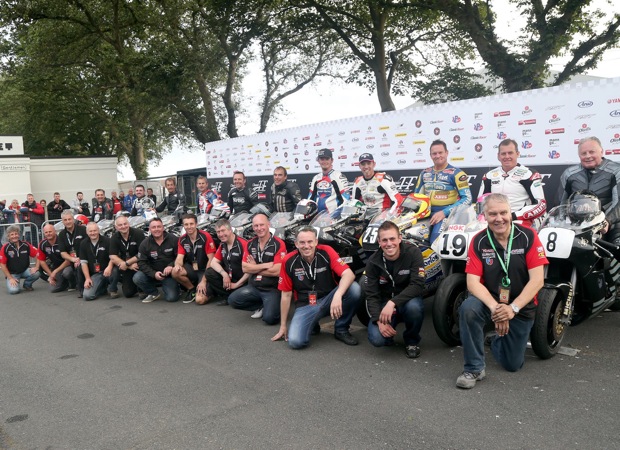Classic TT fans treated to Norton Nostalgia with parade lap around the Mountain Course

Fans around the Mountain Course were treated to one of the biggest highlights of the 2015 Classic TT presented by Bennetts – Norton: The Rotary Years sponsored by the Isle of Man Steam Packet Company – a parade and celebration of the Norton rotary motorcycles that took countless wins and podiums in the British Championship, as well as at the Isle of Man and other International road races between 1987 and 1994.
The Norton rotary has appeared in many parade laps around the Mountain Course – and, of course, enjoyed tremendous race success – but never before have so many appeared in one time on the island. Indeed, Saturday’s lap saw no less than 12 of the revolutionary machines, owned by the National Motorcycle Museum, take to the 37.73-mile course.
The first incarnation of the rotary developed by Brian Crighton, the driving force behind the machines, was the RCW and that formed more than half the parade line up with seven of the black clad John Player Special sponsored machines lapping the Mountain Course.
A number of the riders appeared on their original bikes while appropriate replacements were identified to represent some of the greatest names in Motorcycling history.
The first bike to get the parade underway was the RCW Twin Shock prototype, a bike that was built for Steve Spray, who rode for JPS Norton in 1989 and 1990 after a successful outing at Brands Hatch at the end of 1988. ITV4’s Steve Parrish was on-board the machine that is adorned with the number 0.
Fellow ITV4 commentator James Whitham was next away, riding the number 0 machine made famous by Ron Haslam, who returned to the British Championships after many years in the 500cc World Championship. Haslam rode for the JPS team for two years, taking numerous wins and podiums.
The third machine to leave the line was the number 4 machine ridden today by Michael Rutter. This bike was taken to great success by the late Robert Dunlop, who was part of the Norton team between 1990 and 1992 and who finished third in the 1990 Formula One TT, his first race around the Mountain Course on one of the rotary machines.
Wiltshire rider Trevor Nation, Robert’s teammate for two of those years, was reunited with his familiar number five machine. Nation was an integral part of the Norton team from 1988 until 1991 and, like Dunlop, he took a rostrum finish at the 1990 TT event, taking second behind Carl Fogarty in the Senior race.
Ulsterman Steve Cull, who had a solitary season with JPS Norton in 1989, was another original team member who appeared. The then outright TT lap record holder was out of luck at the TT that year but riding under number 8, the Bangor rider did take a strong third in the Ulster Grand Prix Formula One race, only defeated by Steve Hislop and Carl Fogarty.
Another of the ITV4 team – Steve Plater – took the number 17 machine, Ray Stringer’s career-long number, the Leicestershire rider having selected outings on the JPS Norton in 1990.
The other RCW Rotary to leave the line was campaigned by Steve Spray who dominated the 1989 Shell Supercup and MCN Superbike Championships. Peter Hickman, the fastest ever TT newcomer, rode the number 17 machine that Nottingham’s Spray was so successful on.
The next stage of development of the 588cc machine was the NRS Rotary. Ridden at the TT in 1991 by Nation and Dunlop, the former set the first 120mph lap on the machine during the Formula One race and finished third although he was later disqualified for an oversize fuel tank. Conor Cummins got his first taste of a rotary Norton, adorned with Nation’s regular number five.
Robert Dunlop was the second NRS rider in 1991, and again in 1992. Like Nation, he suffered disappointment at the 1991 TT but made amends a year later when he took third in the Senior TT race and set his fastest ever lap of the Mountain Course at 121.53mph. His youngest son, Michael, no stranger to Norton, took the second number 4 machine out in the parade.
The final works NRS Norton Rotary in the parade was arguably the most famous - ‘The White Charger’ that the late Steve Hislop famously rode to victory in the 1992 Senior. Voted the greatest TT race of all time, Hislop rode under number 19 that day to defeat Carl Fogarty by just 4.4s and 23-times winner John McGuinness had the honour of riding the machine in Saturday’s parade.
The last rotary machine that completed the parade was never actually raced at the TT but was arguably, the most successful – the Duckhams QXR Crighton Rotary. Mark Farmer and Jim Moodie rode the machine in 1992 and 1993 respectively but another Scots ace, Ian Simpson, replaced Moodie in the team in 1994 where Phil Borley joined him. Together, the duo were rampant dominating races up and down the country. However, it was Scots ace Simpson who won that year’s British Superbike Championship. Simpson was reunited with the number 25 machine that took him to the title.
William Dunlop was the final rider out in the parade, riding under number 6. The bike was the same one that he will ride in Monday’s Formula One Classic TT race and is a bike that was originally developed alongside the Duckhams QXR machines.